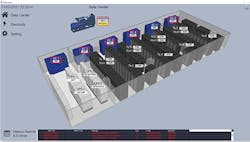Marcia Gadbois is president and general manager of ADISRA. She is an entrepreneur who has grown a start-up from inception to a successful liquidity event. Prior to joining ADISRA, Gadbois was the president of InduSoft, which was acquired by Invensys. In the past, Gadbois held a number of high-tech senior-management positions in the area of business development, strategy, competitive intelligence, marketing and sales.
Gadbois has more than 34 years’ experience in the software industry in diverse technology areas such as artificial intelligence, operating systems, rapid application development environment, output management, databases, directory services, data recovery, middleware and industrial automation. She’s also a contributing author in the book, “Client/Server Programming With RPC and DCE” as well as author of many articles and whitepapers; and she holds a bachelor of science degree in management information system and computer science from Bowling Green State University and an executive MBA from University of New Hampshire.
What are three key things that a machine builder, system integrator or manufacturer should know about your organization?
Marcia Gadbois, president and general manager, ADISRA: ADISRA’s products—SmartView, InsightView and KnowledgeView—are designed for machine builders and system integrators, and they are affordably priced for small-to-mid-market companies. Our products are designed to work together or operate independently, so machine builders can expand and adapt functionality easily to meet their user’s needs.
ADISRA SmartView is an HMI/SCADA package that provides machine builders with the run-time ability to create, configure, delete and change tags, triggers, schedulers, alarms, drivers, database and history. This allows machine builders to offer their end users an application that can be customized to their environment at run-time.
ADISRA SmartView's small footprint and remote viewing feature provides machine builders the design flexibility to accommodate various price points while enabling remote access to their industrial device.
Additionally, ADISRA SmartView offers the drivers and open protocols to connect humans, data and machines.
What new technologies are driving product development and why?
Marcia Gadbois, president and general manager, ADISRA: COVID-19 has changed the way machine builders and the manufacturing industry operate. Demand for products surged, and it caused stress on the supply chain. Manufacturers are reevaluating their situations and are now more focused on building resilience throughout their plants, supply chains and extended ecosystems.
Digital transformation was underway both within the manufacturing industry and in the vendor community prior to COVID-19. However, COVID motivated software vendors to accelerate their digital transformations and adopt technology to meet users’ pandemic generated needs sooner than the original product implementation schedule.
ADISRA's product strategy offers our users flexibility and open standards. We provide scalable, flexible, and adaptable software and licensing methodologies that smoothly conform to our users' business goals.
Remote operations are the new norm in the manufacturing industry, and it will become ubiquitous in the future. ADISRA continues to evolve its remote capabilities along with the necessary and important security component. Robust security-related technologies are an absolute core requirement whose position was heighted by remote operations, which increase concerns about security vulnerabilities. An end-to-end adaptive security environment is a predominate extended manufacturing ecosystem requirement now and in the future.
Analytics and machine learning play a major part of ADISRA's product strategy. Data is being collected from sensors, programmable logic controllers, and other devices and is then visualized and controlled with HMI/SCADA packages. HMI/SCADA software is evolving to provide analytics closer to the data source, as well as in the cloud. Given the large amount of data being collected in normal plant operations, analytics and data-driven decision-making must be performed closer to the data source in order to responsively transform an organization into an analytic-driven digitalized industrial operation.
How does the Industrial Internet of Things figure into business strategy?
Marcia Gadbois, president and general manager, ADISRA: The Industrial Internet of Things (IIoT) is an integral part of our overall business strategy. The COVID-19 pandemic has accelerated IIoT growth with connectivity and remote access being a top priority for many businesses. IIoT also brings data processing, collection and delivery closer to the data source.
Marcia Gadbois, president and general manager, ADISRA
ADISRA believes in the intelligent edge where trained intelligence models are shifted closer to where the data is generated, which creates a demand for processing, storage, connectivity and performance closer to the edge.
How will machine automation and controls alter the way companies staff their operations in the future?
Marcia Gadbois, president and general manager, ADISRA: The workplace will change with enhanced connectivity, artificial intelligence and robotics. However, these changes present substantial opportunities, requiring companies to adapt and work smarter.
Enhanced connectivity and IIoT will grow the volume of data collected in an exponential manner. Combining real-time data with other data sources, such as historical and vendor, will augment worker decision-making by providing actionable insights derived from the massive amount of data collected (Figure 1). Connectivity will enable enhanced remote capabilities throughout a manufacturer's organization that rely on essential workers and robots.
Software visualization and its capabilities is another significant trend that will evolve to meet the needs of a younger workforce. Our younger generation has grown up on video and augmented reality games. They expect a much richer, innovative and modern software work environment.
How is the development of software solutions impacting requirements for hardware?
Marcia Gadbois, president and general manager, ADISRA: Hardware and software have an interdependent symbiotic relationship. As software technology evolves, the hardware must evolve to support the expanded capabilities. The same is true for software. As hardware platforms adopt new technology, software must adapt to support it.
An old example that highlights this symbiotic relationship between hardware and software is the Digital Equipment Corporation introduction of the Alpha chip—hardware—in the early 1990s. The Alpha chip was a 64-bit reduced instruction set computer (RISC) design. Unfortunately, from an end user’s point of view the 64-bit Alpha-chip machine was irrelevant, given the software that ran on the machine was operating only in 32-bit.
As engineering and IT continue their convergence, which one is and/or will be leading the direction of future automation and technology?
Marcia Gadbois, president and general manager, ADISRA: Operation technology (OT) and information technology (IT) must collaborate and align previously siloed data, system and security models to share and use business intelligence more effectively. The collaboration benefits will streamline workflows, improve productivity and increase the bottom line.
There will be challenges in this OT and IT collaboration. Each has different approaches to security, data management and system availability based on distinct priorities. Additionally, there are inherent incompatibilities that exist between OT devices and the IT environment, such as communication protocols.
Also read: The 6 levels of industrial autonomy
The IIoT device proliferation throughout corporations will increase pressure for a fluid OT and IT collaborative relationship so the corporation may benefit from the new efficiency level gains and develop strategic new business models. A successful OT/IT collaboration will position corporations for the future and take advantage of the constantly evolving technology.
Looking into the future, how will technology change your organization or other organizations over the next five years?
Marcia Gadbois, president and general manager, ADISRA: Technology is evolving rapidly, and software vendors and our users must strive to keep pace with the digital technologies’ acceleration. The future technology-savvy workforce will expect software vendors to embrace new technologies and leading-edge form factors.
Extended reality (XR), virtual reality (VR) and augmented reality (AR) are emerging from the gaming world into mainstream industries, such as manufacturing and healthcare. As these technologies continue to evolve, software vendors such as ADISRA must transform our software solutions and incorporate these new technologies. Other leading-edge technology such as glasses, watches and virtual screens will proliferate and become accepted in mainstream industries.
Progressive new form factors and technology will continue to expand as humans demand more convenience and efficiencies from their technology platforms.
Mike Bacidore is the editor in chief for Control Design magazine. He is an award-winning columnist, earning a Gold Regional Award and a Silver National Award from the American Society of Business Publication Editors. Email him at [email protected].
About the Author
Mike Bacidore
Editor in Chief
Mike Bacidore is chief editor of Control Design and has been an integral part of the Endeavor Business Media editorial team since 2007. Previously, he was editorial director at Hughes Communications and a portfolio manager of the human resources and labor law areas at Wolters Kluwer. Bacidore holds a BA from the University of Illinois and an MBA from Lake Forest Graduate School of Management. He is an award-winning columnist, earning multiple regional and national awards from the American Society of Business Publication Editors. He may be reached at [email protected]

Leaders relevant to this article:



